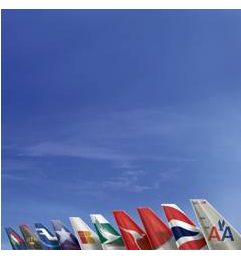JAL's new management team has been appointed to help in its recovery report this week of their "neutral stance" in the battle between its oneworld partners (led by BA/American Airlines) and rivals SkyTeam (led by Delta and Air France-KLM) to be victorious in gaining access to JAL's significant global network.
And in the context of the US-Japan open skies agreement, which was given regulatory approval in December, JAL will factor into its decision the opportunities that Delta and American Airlines connections can bring to this all-important market.
Value of the Domestic Market
Our Routes News analysis shows that oneworld and SkyTeam are, in fact, pitching for almost half of the Japanese domestic market, as JAL currently has a 41% market share of routes from its two hubs at Haneda and Narita.
All Nippon Airlines (ANA) - a Star Alliance member - already controls a marginally higher slice of domestic traffic (43%), and retains its dominant position in the market.
In contrast, oneworld's seven carriers have a valid reason to feel uneasy by JAL's deliberations - after all, the alliance provides passengers with a means to reach over 40 Japanese destinations through JAL and its affiliates: JAL Express or Jalways, and it has access to a market of 120 million potential passengers. Without this key Japanese partner, there are questions about whether oneworld can be a truly global alliance.
JAL's speculated withdrawal from oneworld and move to the SkyTeam would see it allied in Asia with Korean, China Southern and Vietnam Airlines, while Star has Air China, ANA, Asiana, Singapore Airlines, Shanghai Airlines, Thai, Air India and Air New Zealand.
Oneworld would be left with one Asian carrier, Cathay Pacific (in which Air China has a 30% stake, although Cathay's acquisition of Dragonair offers good access to the Chinese Mainland) - along with Australian partner Qantas.
Meanwhile other carriers are left to snatch some of the Japanese traffic as JAL reserves its energies for the negotiating table and a restructuring.
Value of the International Market
A closer examination of international routings out of Japan reveals what SkyTeam could stand to gain from the JAL partnership.
| Alliance | Share of the international market from Japan |
| oneworld | 22% |
| Star Alliance | 21% |
| SkyTeam | 11% |
Skyteam has the weakest market share of international services from Japan (11%) and therefore uniting with JAL would make sense - creating the largest alliance in Japan.
A further breakdown in the data shows a marked difference in seat capacity offered by rivals JAL and ANA from Japan to international destinations - making JAL the largest carrier in Japan (in volume terms) from its home market.
| Carrier | Seat capacity (Weekly) |
| JAL | 106,472 |
| ANA | 78,236 |
Data source: FlightBase
Value of the US-Japan Market
The US-Japan open skies agreement in December has opened up possibilities for multiple services between the lucrative US and Japan market. Between October 2008 and 2009, the average one-way fare between Tokyo and New York was over $1,700 (€1,200), with over 350,000 passengers flying on the route during this period. (Source IATA Airport IS)
Routes News has compared the schedules of American Airlines, Delta (including its acquisition of Northwest's routes) and Japan Airlines from key US gateways to Tokyo (Narita), to find out what value a partnership with either alliance members could bring to JAL.
This data is summarised:
| Carrier | American Airlines | Delta | Northwest |
| ATL | 7 | ||
| DFW | 14 | ||
| DTF | 12 | ||
| HNL | 7 | 21 | |
| JFK | 7 | 7 | |
| LAX | 7 | ||
| MSP | 7 | 7 | |
| ORD | |||
| PDX | 7 | ||
| SEA | 7 | ||
| SFO | 7 | ||
| Total Frequency | 35 | 7 | 75 |
Value of SkyTeam or oneworld to JAL
Looking at feed from the major gateways into JAL's Japanese hubs, SkyTeam's Delta has benefited from access to Northwest's route network and the alliance therefore offers a significantly higher proportion of flights from the US to Japan compared with oneworld's American Airlines. Therefore SkyTeam could potentially be more attractive to JAL based on the US-Japan sector.
Given the importance of JAL in the Far East region and the many potential benefits of joining up its dots with SkyTeam's strong Asia network, its final decision may well depend on which alliance can offer JAL the most support as it attempts to turn itself around into a profitable carrier.
 Oneworld without JAL: A true global alliance?Losing JAL would leave oneworld with just one Asian carrier, Cathay Pacific (in which Air China has a 30% stake. Dragonair provides good access to the China Mainland though).
Oneworld without JAL: A true global alliance?Losing JAL would leave oneworld with just one Asian carrier, Cathay Pacific (in which Air China has a 30% stake. Dragonair provides good access to the China Mainland though).





